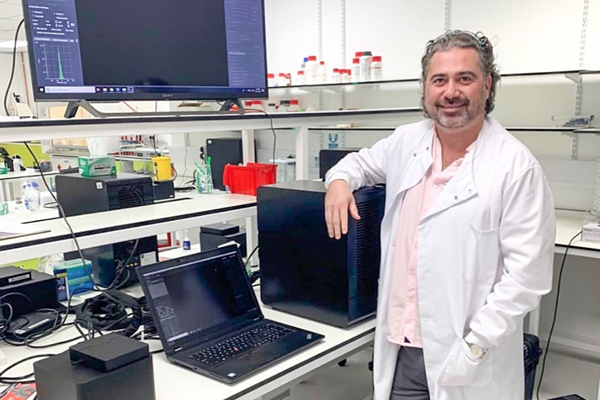Our Facility and Equipment

NTA and DLS are both techniques utilized in the Research and Development (R&D) and Quality Control (QC) laboratories for the analysis and characterization of nanoparticles in solution. NTA analysis is performed using a Malvern Panalytical NanoSight NS300 instrument, while the DLS analysis is performed using the DynaPro® NanoStar® instrument. Both instruments accurately measure the size distribution and concentration of all types of nanoparticles; however, the DynaPro® NanoStar® can differentiate between particle families, and can also be used for proteins, quantum dots, liposomes, metallic nanoparticles, and other types of particle analysis.
This state-of-the-art super-resolution microscope can capture images of a single extracellular vesicle (EV) in solution. Both, MSCs used in the manufacturing process as well as exosomes manufactured at Kimera Labs are characterized by different means, and nothing captures better multi-color 3D images at 100x resolution than our ONI super-resolution microscope.
The Pico is a cell imaging system used at Kimera Labs for cell characterization, as well as for potency assay testing analysis. Whether running fluorescence imaging or brightfield assays, the automated imager has preconfigured protocols that can be used for the development of cell-based assays, which have proven extremely helpful for R&D studies.
HPLC is a technique used for the characterization of the EVs in solution, as well as to determine the concentration and purity of the product. Precise and accurate characterization of the finished vialed product is performed by Size Exclusion Chromatography (SEC) using our Agilent® 1260 Infinity II HPLCs which are equipped with both Diode Array Detector as well as Fluorescence Detector.
Western Blot technique is used to determine the presence of surface markers commonly found on EVs. As part of the characterization and analysis of each EV-lots manufactured at Kimera Labs, identification of these markers (e.g. CD81, DC63) by WB is a routine technique utilized to support the identification and concentration of the product.
One of the most commonly used techniques for the isolation, purification, and characterization of different biological products is differential centrifugation. Ultracentrifugation is widely used in the purification and characterization of EVs. In our R&D lab, ultracentrifugation techniques have enabled us to continue improving our processes and methods used for EV analysis and characterization.
RT-PCR is one of the most sensitive techniques for the detection, quantitation, and characterization of RNA currently used in laboratories worldwide. RT-PCR is used at Kimera Labs to accurately characterize the cargo of our EVs. RT-PCR is used to support the analysis of our potency assays, as well as to effectively and accurately compare the RNA cargo of each lot manufactured at our facility.
Our Illumina NextSeq 1000 System, one of the newest and most advanced sequencing instruments available in the market enables us to accurately determine the exact RNA cargo and concentration in our EV products. Our NextSeq 1000 System allows us to accurately use this technology in the analysis and characterization of EVs, while enabling the development of products that perhaps a few years ago were not even imaginable. When samples are processed in our NextSeq 1000 System, we can accurately determine the exact sequence of each of the cargo RNA, as well as the concentration of each specific RNA family. This further assures that our processes are under control, and the quality of the product is been maintained from lot to lot.
At Kimera Labs, the entire cGMP manufacturing process (upstream and downstream) is conducted inside our ISO 7 certified cleanrooms, which contain multiple ISO 5 certified Laminar Flow Glovebox Isolators (LFGIs). ISO certification not only ensures compliance with the most rigorous environmental control standards but also helps to reduce the possibility of contaminating the product while been processed. From procedure-driven routine and meticulous aseptic cleaning of the rooms to recurring environmental monitoring, nothing is left to chance when the sterility and quality of the product are at stake. The room as well as the LFGIs are equipped with High Efficiency Particulate Air (HEPA) filter, which traps particles that are 0.3 microns and larger. Multiple UV-C lights in the room, inside the LFGIs, as well than in the AC ducts are used to further assist in maintaining the sterility of the room.
